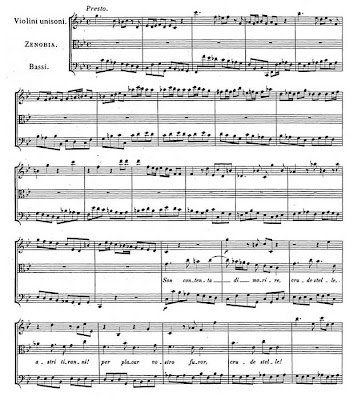Handel, Radamisto, J. DiDonato, P. Ciofi, M. Beaumont, Il Complesso Barocco, A. Curtis Virgin 7243 5 457673 2 2 |
The piece of the Santa Fe season that was missing was Baroque opera, something that the company has remedied with Rameau’s Platée last summer and Handel's Radamisto, which opens tonight. True, neither work cracks the 17th-century barrier -- Lully? Monteverdi? anyone? -- and Santa Fe has not partnered with an established historically informed performance (HIP) ensemble, but we will take what we can get. The conductor, Harry Bicket, is a specialist with some impressive Handel work in his discography. Still, imagine William Christie with Les Arts Florissants or Alan Curtis with Il Complesso Barocco in the Santa Fe Opera pit -- my job is only to dream big, and it is up to the opera professionals to deal with the challenges of making something like that happen.
| Online Score: HWV 12a/12b (Ausgabe der Deutschen Händelgesellschaft, ed. F. Chrysander, vol. 63 [Leipzig, 1875]) |
 Handel, "Son contenta di morire," from Radamisto One of the more interesting arias, for Zenobia, with its odd violin obbligato and jagged, odd chromatic turns |
Santa Fe appears to be performing the 1728 version of the opera, for which Handel cut the role of Fraarte (no singer has been announced for the role at Santa Fe). Handel first conceived the title role for Margherita Durastanti, a soprano who tended toward mezzo-soprano territory (a voice probably quite like Joyce DiDonato) and trouser roles. The production of Radamisto at Santa Fe will feature the countertenor David Daniels, shifting us to the later versions of the opera, in which Handel recast the title role for the alto castrato Senesino.
For Polissena, who was always a high soprano in all three versions, Santa Fe has a high soprano, Laura Claycomb (like Curtis, who had Ciofi). Handel created the role of Zenobia for a low female voice (Anastasia Robinson), modifying it twice, for soprano (Durastanti) and mezzo-soprano (Faustina Bordoni). Mezzo-soprano Deborah Domanski stepped in just this week to replace Christine Rice at Santa Fe, which again indicates the 1728 version, as does the casting of bass-baritone Luca Pisaroni as Tiridate. Soprano Heidi Stober as Tigrane, however, seems to lean toward the earlier versions (for soprano and soprano castrato). David Alden has created a new production for this opera's first appearance at Santa Fe. Almost all of the principal singers are new to Santa Fe, except Stober and former apprentice singer Kevin Murphy (Farasmane).
Handel's Radamisto will be performed on July 19 and 23, August 1, 7, 15, and 20, at Santa Fe Opera.
Hooray that you'll be blogging from Santa Fe. I'm bummed I can't make it, and excited you'll be there.
ReplyDeleteI went to last night's performance. Can anybody explain Tigrane's costume to me? I mean, she *was* wearing Birkenstocks and a fez, right?
ReplyDeleteI have seen the show about 8 times now (I work on it) and I think that the singing is incredible but I still can't figure out some of the design choices.
ReplyDeleteI'm so excited to be going. More about the Birkenstocks and fez later this week!
ReplyDeleteI'm going later this week and am really looking forward to it. When Santa Fe did Xerxes a number of years ago, the only singers who seemed comfortably free with baroque ornamentation were the countertenors, so I'm hoping to hear how things have developed.
ReplyDeleteAnd as an (alas, former) continuo player, I'm very interested in hearing what's going on there. I may not be remembering right, but I think that for the Xerxes performance they only had a harpsichord and a theorbo(maybe the latter is wishful remberence on my part), but I'm hoping for a bit more variety there, too. Anyone know what sort of continuo forces Handel had for this show? (in any of its guises)
We are on our 8th season at the Santa Fe Opera (the last 7 as full season ticket holders) and saw Radamisto last night.
ReplyDeleteI would love to read some discussion of the stage direction/design choices.
We felt that this was the WORST set design ever. It was ugly when it was apparently supposed to be Baroque to the max, and the wall shifts seemed aimless. The elephant/tiger looked like a blob. The "mirror" set in the second half resulted in blinding flashes when doors opened or sections moved. The dragon? Why? The leopard stuck with arrows at the end? Gee, I wonder what THAT was meant to symbolize? Why not just hold up a big sign?
We found the stage direction distracting at best. Singers came onto the stage and stood (or crawled) around and then left. And Tigrane's Groucho Marx costuming - with Birkenstocks and socks - was just bizarre.
I found myself focusing on each singer and trying desperately to ignore the rest of the stage.
OK, rant over!
The orchestra was wonderful, the music beautiful and the voices sublime. If only....
Well, mimi, the "Still Not an Operatic Convert" post on LJ and Vox is mine, and there are a few comments on each site. Just be warned that I am a confirmed instrumentalist. :-)
ReplyDeleteYes, I hated the stage direction, even if I liked the Baroque look of some of the set design. I actually liked the *concept* of the mirrored set, but you are right, the execution didn't really work.
I guess I'm too young to know what everybody means by "Groucho Marx costuming." Does that reference (which I have seen in another review) explain the choice at all? I just thought she looked like Indy's friend Sallah.